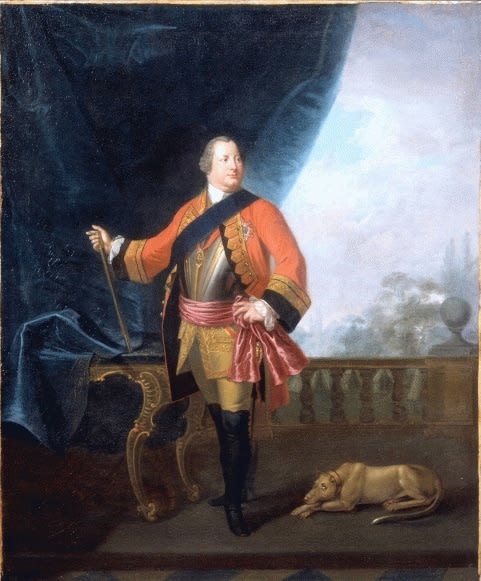
David Morier
To view all current artworks for sale visit philipmould.com
The Swiss painter David Morier is best known for his portraits of members of the Royal family and senior army officers, produced in the middle years of the eighteenth century. His work is marked by a meticulous attention to detail in uniform and equipment, which recommended him to military patrons then as it has done to military collectors since. By far the most frequent subject of Morier's portraiture is William Augustus Duke of Cumberland, whose protégé Morier became some time after his arrival in London in 1743. Three years later Cumberland achieved great renown as the victorious commander of the Government forces against the Jacobite rebels at Culloden, and from 1748 Morier produced a great many paintings that record the prince and his family in this and other martial guises, all executed with an accuracy that made Morier the soldier's painter. In recognition of this the painter was awarded a pension of £200 per annum by Cumberland.
The subjects portrayed are - necessarily - almost always shown mounted and on the field of battle or review, which makes the present painting with its deliberately pacific and almost domestic character remarkable. The Duke is depicted in an interior, or at least on a terrace that opens to a landscape shielded by a curtain, a landscape which though hidden is plainly that of a park rather than a battlefield. Two studio variants on this composition in London collections, one in the National Army Museum and the other in the National Portrait Gallery, enclose the setting with an interior wall and window, through which a military camp can be seen, although they preserve the balustrading of a nobleman's house. At Cumberland's feet rests a devoted hound, whose recumbence suggests the sleep of the just and the security of the victorious.
Cumberland is nonetheless shown in full uniform and - as would no longer have been worn in action - a cuirass, which is still, pictorially, as much a part of the commander's dress as the baton which the prince carries. The delicate pier table on which this latter rests is perhaps remarkable for its continental and unmartial associations, but this too hints that the campaign is over and has been concluded successfully. It may also have proved an irresistible feature for a painter working during the decades when British taste was still attempting to evoke the spirit of the rococo by such piecemeal inclusions.
For the connoisseur of uniforms the Duke is wearing a general officer's State Coat of c.1750 pattern, although there is one unorthodoxy in his dress. Uniquely he is wearing the star and riband of the Garter, with which the Duke was invested in 1730, with the badge of the Order of the Bath around his neck. No other subject might belong simultaneously to both orders. This second-ranking order was revived in 1725, having fallen into disuse, and the young Prince William, then Duke of Gloucester, was appointed its head despite his years. A portrait was commissioned from Joseph Highmore to show the young prince in the Bath robes, but it did not please the King and never entered the royal collection. An engraving was prepared, but by publication this had been altered to show the Garter that the prince received in 1730. The earlier composition is recorded only in a small painting by or attributed to Highmore (Charlecote Park, National Trust). This painting, a beguiling image of the four-year-old child prince in Bath mantle and chain, hints at the favouritism that William Augustus was shown by his parents. Cumberland was from his birth the darling of his parents, to the detriment of his elder brother, the heir Fredrick Louis Prince of Wales. The particular communion that George II and his younger son enjoyed, and the isolation of his heir, may be seen as well in their choice of painters as in any other aspect of their public lives. The flimsy rococo and outdated continental Baroque idiom in which the Prince of Wales was so often painted are a telling contrast to the common enthusiasm for encampments and warfare that animate the Morier portraits of George II and the Duke of Cumberland.
The extent to which the Duke of Cumberland's reputation has suffered at the hands of those who criticised his treatment of the defeated Jacobites is perhaps the best-known aspect of his career. Out of jealousy - Horace Walpole had said of Cumberland in 1745: ''the soldiers adore him, and with reason; he has a lion's courage, vast vigilance and activity, and, I am told, great military genius'' (Letters ii 4) - his brother and Jacobite sympathisers lost no time in encouraging the excoriation of Cumberland as ''the Butcher'', for his harsh, though necessary, eradication of all resistance in the Highlands. The prudent, however, recognised that no peace was ever to be had from a territory that had the inclination to make rebellion and the means to support it.
Be the first to hear about our available artworks
* denotes required fields
We will process the personal data you have supplied in accordance with our privacy policy (available on request). You can unsubscribe or change your preferences at any time by clicking the link in our emails.